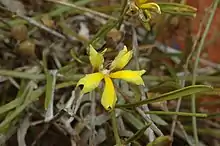| Silky goodenia | |
|---|---|
 | |
| Scientific classification | |
| Kingdom: | Plantae |
| Clade: | Tracheophytes |
| Clade: | Angiosperms |
| Clade: | Eudicots |
| Clade: | Asterids |
| Order: | Asterales |
| Family: | Goodeniaceae |
| Genus: | Goodenia |
| Species: | G. fascicularis |
| Binomial name | |
| Goodenia fascicularis | |

Goodenia fascicularis, commonly known as silky goodenia,[2] is a species of flowering plant in the family Goodeniaceae and is widely distributed in eastern continental Australia. It is an ascending perennial herb with linear to egg-shaped leaves and racemes of yellow flowers.
Description
Goodenia fascicularis is an ascending perennial herb that typically grows to a height of 20 cm (7.9 in) and has hairy foliage. It has linear to egg-shaped leaves 20–140 mm (0.79–5.51 in) long, 4–25 mm (0.16–0.98 in) wide at the base of the plant and smaller leaves on the stem. The flowers are arranged in leafy racemes up to 100 mm (3.9 in) long on a peduncle 20–70 mm (0.79–2.76 in) long. The sepals are lance-shaped, 2.5–4 mm (0.098–0.157 in) long, the corolla yellow, 12–23 mm (0.47–0.91 in) long. The lower lobe of the corolla is 5–10 mm (0.20–0.39 in) long with wings 1.2–2.5 mm (0.047–0.098 in) wide. Flowering occurs in most months and the fruit is a more or less spherical capsule 5–8 mm (0.20–0.31 in) in diameter.[2][3][4][5][6]
Taxonomy and naming
Goodenia fascicularis was first formally described in 1890 by Ferdinand von Mueller and Ralph Tate in the Transactions, proceedings and report, Royal Society of South Australia from material collected in the Basedow Range (near Imanpa) in the Northern Territory, during the Tietkens expedition to Central Australia.[7][8] The specific epithet (fascicularis) means "belonging to a small bundle".[9]
Distribution and habitat
This goodenia grows in a wide range of habitats including scrub, woodland and grassland west of Tamworth in New South Wales, in northern and north-western Victoria, and in Queensland, the Northern Territory and South Australia.[2][3][4][5][6]
References
- ↑ "Goodenia fascicularis". Australian Plant Census. Retrieved 22 January 2021.
- 1 2 3 Jeanes, Jeff A. "Goodenia fascicularis". Royal Botanic Garden Sydney. Retrieved 22 January 2021.
- 1 2 Carolin, Roger C. "Goodenia fascicularis". Australian Biological Resources Study, Department of Agriculture, Water and the Environment: Canberra. Retrieved 22 January 2021.
- 1 2 Carolin, Roger C. "Goodenia fascicularis". Royal Botanic Garden Sydney. Retrieved 22 January 2021.
- 1 2 "Goodenia fascicularis". Government of the Northern Territory. Retrieved 22 January 2021.
- 1 2 "Goodenia fascicularis". State Herbarium of South Australia. Retrieved 22 January 2021.
- ↑ "Goodenia fascicularis". APNI. Retrieved 22 January 2021.
- ↑ von Mueller, Ferdinand; Tate, Ralph (1890). "List of Plants collected during Mr. Tietkens' Expedition into Central Australia, 1889". Transactions, Proceedings and Report, Royal Society of South Australia. 13: 108. Retrieved 22 January 2021.
- ↑ Sharr, Francis Aubi; George, Alex (2019). Western Australian Plant Names and Their Meanings (3rd ed.). Kardinya, WA: Four Gables Press. p. 197. ISBN 9780958034180.